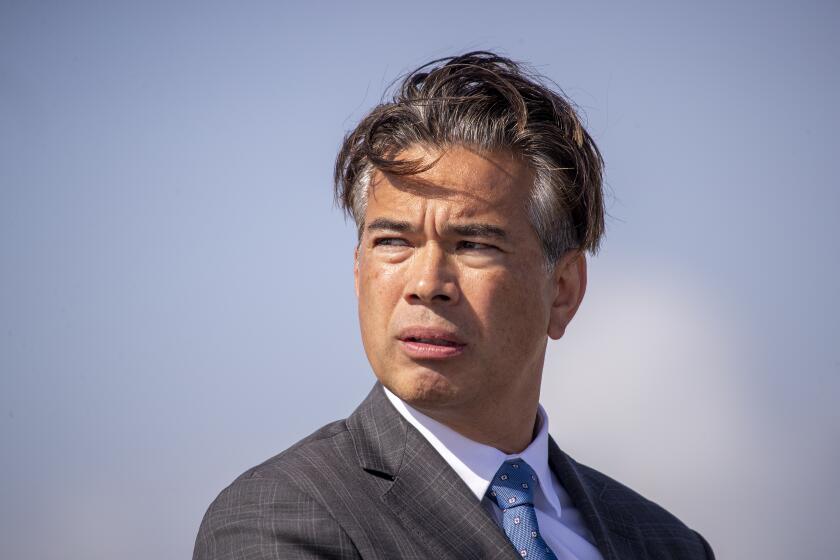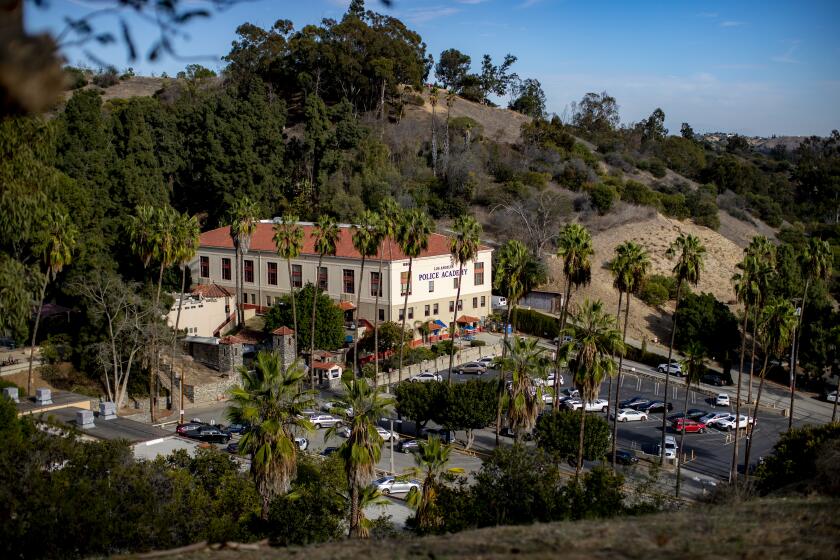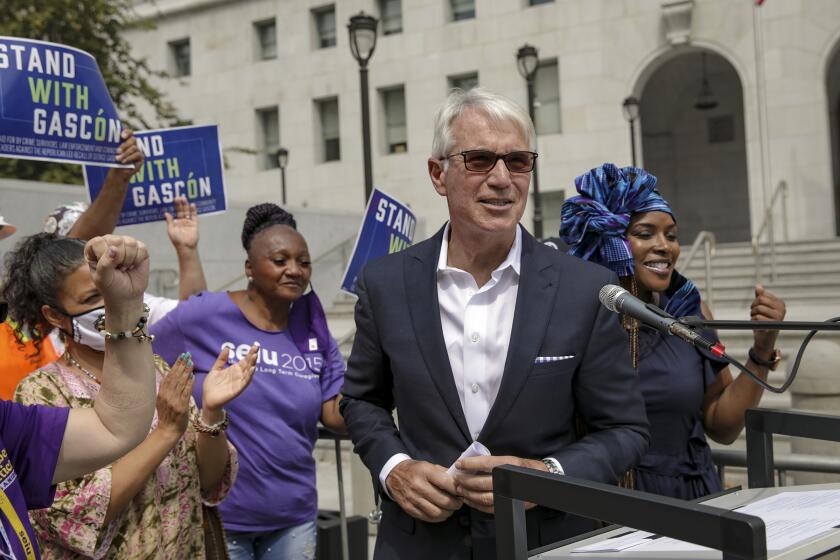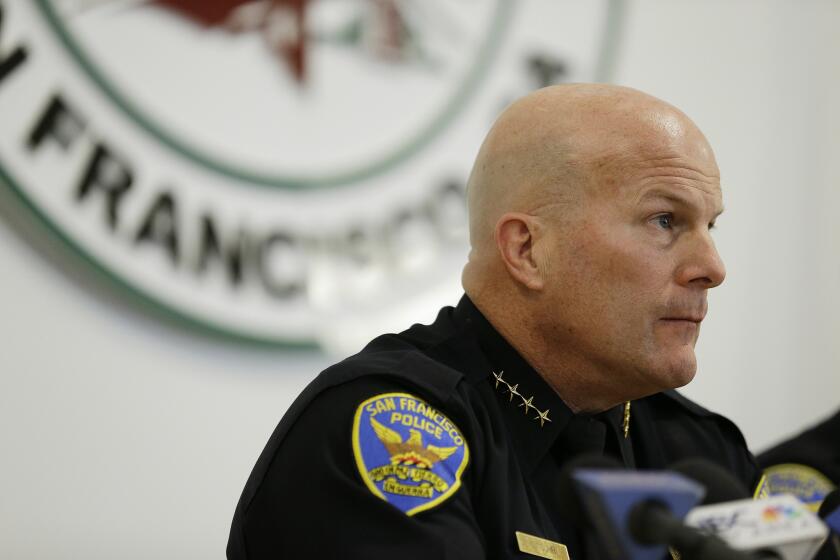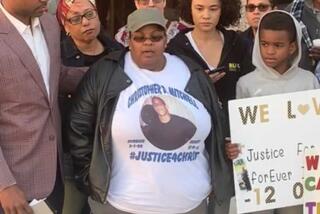Torrance police traded racist, homophobic texts. It could jeopardize hundreds of cases
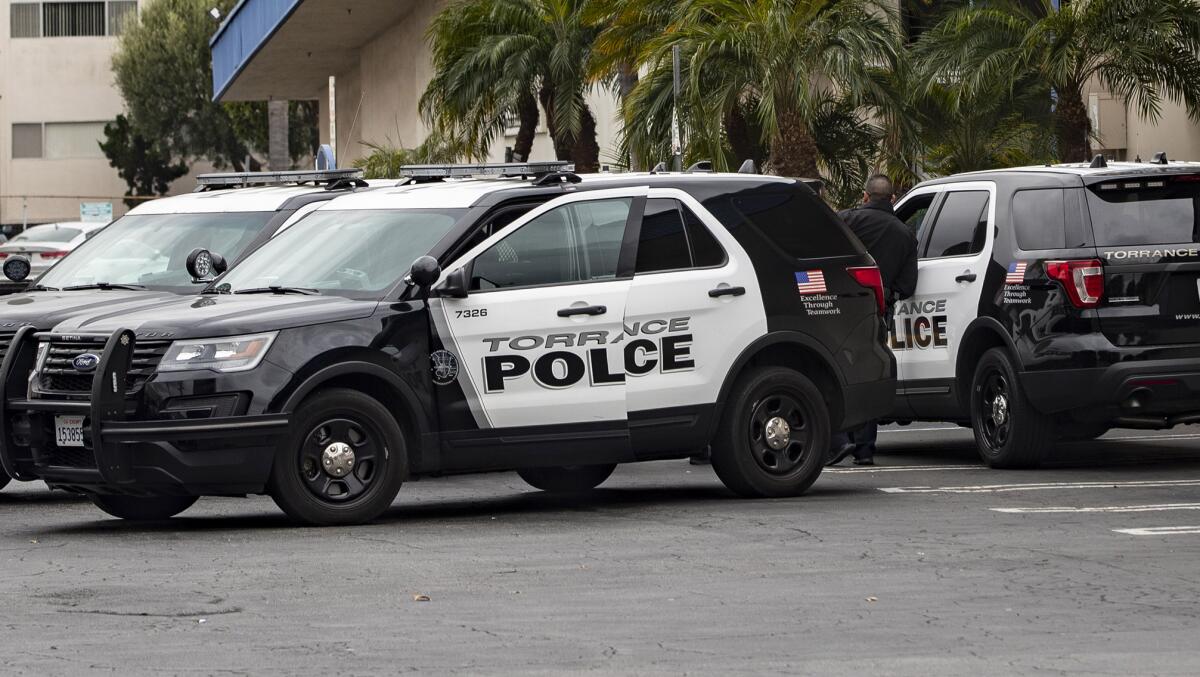
- Share via
The caption read “hanging with the homies.”
The picture above it showed several Black men who had been lynched.
Another photo asked what someone should do if their girlfriend was having an affair with a Black man. The answer, according to the caption, was to break “a tail light on his car so the police will stop him and shoot him.”
Someone else sent a picture of a candy cane, a Christmas tree ornament, a star for the top of the tree and an “enslaved person.”
“Which one doesn’t belong?” the caption asked.
“You don’t hang the star,” someone wrote back.
The comments represent a sliver of a trove of racist text messages exchanged by more than a dozen current and former Torrance police officers and recruits.
Through interviews with sources with direct knowledge of the investigation, public records requests and a review of district attorney’s office records, The Times examined some of the contents of the until-now secret texts and identified a dozen Torrance police officers under investigation for exchanging them.
The broad scope of the racist text conversations, which prosecutors said went on for years, has created a crisis for the Torrance Police Department and could jeopardize hundreds of criminal cases in which the officers either testified or made arrests. California Atty. Gen. Rob Bonta said Wednesday his office will investigate the department in the wake of the scandal.
California Atty. Gen. Rob Bonta announces an investigation into the Torrance Police Department after a Times report on racist texts between officers.
The officers’ comments spared no color or creed: They joked about “gassing” Jewish people, assaulting members of the LGBTQ community, using violence against suspects and lying during an investigation into a police shooting, according to district attorney’s office records reviewed by The Times.
Frequently, hateful comments were targeted at Black people. Officers called Black men “savages,”and several variations of the N-word, according to documents reviewed by The Times. The officers also shared instructions on how to tie a noose and a picture of a stuffed animal being lynched inside Torrance’s police headquarters, according to the documents.
While no officers currently face criminal charges in direct relation to the text messages, the racist exchanges have led to the dismissal of at least 85 criminal cases involving the officers implicated in the scandal. County prosecutors had tossed 35 felony cases as of mid-November, and the Torrance city attorney’s office has dismissed an additional 50, officials said.
In total, the officers were listed as potential witnesses in nearly 1,400 cases in the last decade, according to district attorney’s records The Times obtained through a public records request. The officers did not necessarily testify in each case, so it’s unclear how many of those cases could be affected.
Still, in the span of one week in November, the Los Angeles County public defender’s office received about 300 letters from prosecutors disclosing potential misconduct by officers implicated in the scandal, said Judith Green, an office spokeswoman.
Two former Torrance police officers were charged with spray-painting a swastika inside of a resident’s car, and prosecutors are now reviewing hundreds of cases involving the ex-cops, officials said.
Prosecutors are reviewing dozens of additional cases linked to the officers, said Diana Teran, a special advisor to Los Angeles County Dist. Atty. George Gascón. The review will prioritize active cases in which a defendant is still in custody and one of the officers implicated in the scandal was a “material witness.”
“So that could be, for example, a single police officer is in a patrol car and sees an individual on the sidewalk and then says he had a bulge in his pocket and then pats him down and then recovers a gun,” Teran said. “Without that officer, you couldn’t prove that case.”
Since 2013, the group of officers identified by The Times has been involved in at least seven serious use-of-force incidents in Torrance and Long Beach, including three that ended in the deaths of Black and Latino men, according to police use-of-force records and court filings. Although the officers’ actions were found to be justified in each case, experts say those cases should be reexamined in the context of the hateful messages.
“What those text messages revealed was an extraordinarily hostile attitude toward people of color, people who are nonbinary, people who have different sexual orientations,” said Walter Katz, a former independent police auditor in California who now serves as a vice president of criminal justice for research firm Arnold Ventures. “I don’t know that we can take anything they’ve said at face value.”
According to an investigation by The Times, the theft of 44 guns from an L.A. gun store has spurred a cascade of allegations against LAPD officers and a roiling department scandal.
Two of the officers under investigation as part of the scandal — Anthony Chavez and Matthew Concannon — are also under investigation for the controversial 2018 slaying of Christopher DeAndre Mitchell, a Black car theft suspect they fatally shot while he was holding an air rifle. Chavez and Concannon were cleared of wrongdoing by former Dist. Atty. Jackie Lacey, but the case is one of several that Gascón has hired a special prosecutor to review for possible criminal charges.
Several of the officers have also been named as defendants in lawsuits alleging excessive force, false arrest and wrongful death, court filings show. In some of those cases, the plaintiffs are members of the same ethnic groups the officers espoused hatred for in the texts.
Gascón has already publicly identified two of the men involved in the scandal as former Officers Cody Weldin and Christopher Tomsic, who were charged in August with conspiracy and vandalism for allegedly spray-painting a swastika inside a vehicle. When Gascón charged Officer David Chandler with assault in late August for allegedly shooting an armed man in the back, sources told The Times that Chandler was also under investigation as part of the scandal.
In addition to Weldin, Tomsic and Chandler, The Times has reviewed district attorney’s records detailing racist texts or images shared by six other police officers: Blake Williams, Brian Kawamoto, Joshua Satterfield, Omar Alonso, Christopher Allen-Young and Long Beach Police Officer Maxwell Schroeder, who is a former Torrance police recruit.
Concannon, Chavez and fellow Torrance Police Officers Andrew Kissinger and Enrique Villegas are also under investigation as part of the scandal, according to three people with direct knowledge of the case and a review of district attorney’s records. The Times did not independently view documentation of racist text messages sent by any of those four officers, though the newspaper did review a document that showed Concannon sent messages that are part of the investigation.
The identities of all 13 officers named in this article were confirmed by three people with direct knowledge of the case and by reviewing district attorney’s records that detailed some of the officers’ comments. Those people spoke on the condition of anonymity so they could candidly discuss an ongoing investigation.
The text messages were not on one continuous thread, according to two of the sources. Additional officers received the texts but did not interact with them in any way, so they are not considered under investigation, those sources said.
The exact number of officers involved in the scandal is unclear. Sgt. Mark Ponegalek, a Torrance police spokesman, could not confirm or deny the identities of the officers involved, but said 15 have been placed on administrative leave in relation to the scandal.
A Torrance police officer has been charged with assault for his role in a 2018 shooting. The officer has also been implicated in a racist text message scandal involving a dozen other officers.
That number did not include Tomsic, Weldin, or Schroeder, he said. The Times identified 13 officers in its investigation, including Tomsic, Weldin and Schroeder, meaning there are an additional five Torrance officers under investigation whose identities remain unknown to the public.
A Long Beach police spokesman said Schroeder was assigned to desk duty pending the outcome of an internal investigation, but would not say why.
The officers either declined to comment through their attorneys or did not respond to messages left by The Times at their homes or through their union, the Torrance Police Officers Assn., which represents rank-and-file officers. An attorney for the union said the officers were barred from commenting on the investigation.
“The current administrative investigations are confidential. As such, we do not have access to facts of the underlying investigation, or the alleged inappropriate materials. We expect that as police officers, our members should be treated like any other citizen — considered innocent until proven guilty,” the union said in a statement. “Our members have a right to due process and should be protected from illegal and unnecessary intrusion into their private lives.”
::
The text messages might have remained hidden if not for the alleged bizarre actions of Tomsic and Weldin in January 2020.
The two officers responded to a report of mail theft in the South Bay city and directed a car linked to the crime to be towed from the scene, authorities said. The pair allegedly spray-painted a swastika and a “happy face” inside the vehicle, according to a criminal complaint.
District attorney’s records reviewed by The Times showed Tomsic sent a slew of racist images and messages, including a picture of former President Reagan feeding a monkey with a caption stating Reagan “used to babysit [former President] Obama.”
Another picture he sent referred to an “African American baby” as a “Pet Niguana,” according to the records, and he also sent a message mocking the fact that he was the subject of a racial profiling complaint.
“So we totally racially profiled his ass, haha … Shopping at 7/11 while Black, he didn’t know the rules lol,” Tomsic wrote, according to the records.
Torrance police officials acquired evidence of the text message threads during their investigation of Weldin and Tomsic, according to Ponegalek, though he declined to give a specific timeline of when they obtained the data.
Gascón said he first became aware of the situation in July, when he was given a briefing about the pending vandalism charges.
“I questioned whether there was any other things that would lead us to believe that this is not sort of a single crime event,” he said. “I actually made some comments about how, generally, when someone does this kind of stuff, there are bigger patterns of behavior. So, I started asking if we had checked for text messages.”
Within weeks, Torrance police provided the district attorney’s office with more than 200 gigabytes of data, which showed the officers had been exchanging racist messages since at least 2018, according to Teran, the advisor to the district attorney. Gascón praised Torrance Police Chief Jeremiah Hart for moving quickly to provide information to prosecutors, noting he met resistance from police leaders when investigating similar scandals involving racist text messages among San Francisco officers.
Newly disclosed text messages in which a trio of San Francisco Police Department officers referred to minorities as “barbarians,” “cockroaches” and other slurs should trigger an even larger review of past criminal cases for signs of racial bias, according to the city’s public defender.
Gascón said the texts are proof that some Torrance officers hate the communities they were hired to serve.
“It creates a tremendous amount of concern for me. We have a group of officers who, apparently in addition to harboring very biased and racist beliefs, also may be engaging in inappropriate force that could be illegal in some cases,” he said.
In the texts, the officers showed little concern about getting caught and even less about the citizens they were assigned to protect, routinely joking about using force and mocking internal affairs.
“We had to [expletive] her up because we knew he wouldn’t,” one officer wrote in one exchange about an altercation with a female suspect. “Don’t ask me where that lump on her forehead came from though.”
“Sometimes you’ve got to do things your own damn self,” Kawamoto replied, later adding a comment that he wanted to “always make Torrance great again,” a reference to former President Trump’s ubiquitous political slogan.
Kawamoto also referred to Black men as “savages” in the texts, according to district attorney’s records reviewed by The Times.
In another message reviewed by The Times, Alonso complained about the idea of having to work with a gay officer, and said he’d “straight punch” a member of the LGBTQ community, using a common slur for gay men.
Usually, conversations always seemed to circle back to vile insults or depictions of violence against Black people. After one officer shared a news article about someone being arrested for urinating on a Black child and calling them the N-word, Satterfield replied, “what’s the crime?” according to district attorney’s records reviewed by The Times.
From 2016 to 2019, Torrance police upheld just three citizen allegations of police misconduct and zero allegations of racial profiling made against officers, according to data submitted to the California attorney general’s office. Katz, the former independent police auditor, described those statistics as “concerningly low.”
“If citizen complaints are not taken seriously, it does increase the sense of impunity that officers who are inclined toward misconduct have,” he said.
Ponegalek argued that The Times’ analysis was incomplete, as it did not include statistics involving complaints filed by other officers. Torrance police sustained 35 out of 43 internally generated complaints of officer misconduct from 2016 to 2020, Ponegalek said. The department has also hired an outside law firm to conduct a review of the scandal, he said.
::
Many of the officers under investigation as part of the scandal also have use-of-force histories involving the communities for which they expressed hatred.
Schroeder used a carotid restraint hold — sometimes referred to as a blood choke — to subdue a homeless Black man in a park in November 2018, according to Long Beach police records The Times obtained through a public records request. Schroeder initiated contact with the man because he was sleeping in a park after it closed, the records show, and used the choke to take him down after an altercation.
Long Beach police officials determined the use of force was justified, the records show. The homeless man was booked on suspicion of resisting arrest, being in the park after dark and possession of drug paraphernalia, according to a Long Beach police spokesman. Long Beach City Prosecutor Doug Haubert did not respond to repeated calls and e-mails seeking information about the criminal case against the homeless man.
According to the district attorney’s records reviewed by The Times, Schroeder sent one message in the texts reading “No Jews, No Blacks,” and made racist remarks about a child eating a watermelon.
Several of the Torrance officers under investigation as part of the scandal have also used serious or deadly force against Black and Latino men while on duty in recent years, according to district attorney’s records.
Chavez, Williams, Satterfield and Tomsic all opened fire on Michael Lopez in 2017 after a vehicle pursuit that started in Palos Verdes Estates. Lopez had been fleeing police in a truck, and the officers said he attempted to ram them when they opened fire, according to a district attorney’s office memo that determined the fatal shooting was justified.
One year later, Tomsic was one of several officers involved in a deadly altercation with Deautry Ross in the Del Amo Fashion Center, according to district attorney’s records. The officers were responding to calls from a mall employee who said Ross was walking through the building with a knife, muttering to himself. Ross fled from Torrance police when they responded, and became violent when they tried to arrest him, district attorney’s records show.
During the struggle, Tomsic said, Ross tried to gain control of his gun, according to a district attorney’s office memo clearing the officers of criminal liability. The officers hit Ross with a Taser and handcuffed him, but he continued to struggle, according to the report, which then described two officers kneeling on Ross’ shoulders.
Another officer then sat on Ross’ legs before others were able to “bind Ross’ arms and legs with a hobble restraint.”
Minutes later, firefighters on scene noted Ross’ pulse was beginning to weaken. He eventually went into cardiac arrest and was pronounced dead at a hospital a short time later. A knife was recovered at the scene.
Medical examiners ruled Ross died of cardiac arrest resulting from methamphetamine use and his struggle with the officers, according to autopsy records.
The most controversial incident involving officers linked to the racist text scandal is the 2018 shooting death of Christopher DeAndre Mitchell. The incident sparked significant protests — including one inside Torrance’s City Council chambers that led demonstrators to file excessive-force lawsuits against several of the officers The Times identified in this article — and remains under review by Gascón.
Mitchell, who was Black, was suspected of driving a stolen vehicle when he pulled into a Ralphs parking lot in Torrance in December 2018, according to a district attorney’s office memo clearing the officers of wrongdoing. Concannon and Chavez pulled in behind him, exited their vehicle and yelled “police!” Mitchell initially placed his hands on the steering wheel, according to the memo, but when the officers approached him, they noticed his hands move toward his lap where Concannon saw what he believed to be a firearm.
The officers repeatedly ordered Mitchell to get out of the car, but he did not comply, according to the report. The officers described the weapon, later determined to be a “break barrel air rifle,” as “pinched” between Mitchell’s legs, though neither alleged he grabbed it or pointed it at them before they opened fire.
Lacey cleared the officers of wrongdoing in all three deaths, but Gascón has reopened the investigation into Mitchell’s killing . He declined to offer a timetable on that review and would not say whether the officers involvement in the text scandal would affect that probe.
Katz said the text messages call into question the credibility of the officers’ accounts of any past use-of-force incidents involving Black or Latino suspects.
In the Mitchell case, that could be especially concerning. According to district attorney’s records reviewed by The Times, Concannon once sent a troubling text message referring to a deposition he gave in an “officer-involved shooting.”
“They believed our lies. Good job sticking to the script,” he wrote. “LMAO, that’s what they call a W.”
According to a Times review of public records, Concannon has shot only one person during his career: Christopher DeAndre Mitchell.
More to Read
Sign up for Essential California
The most important California stories and recommendations in your inbox every morning.
You may occasionally receive promotional content from the Los Angeles Times.
